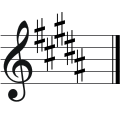G-sharp minor
G-sharp minor is a key of the tonal family minor, which is built on the root g-sharp. The key of G-sharp minor is written in musical notation with five crosses (F-sharp, C-sharp, G-sharp, D-sharp, A-sharp). The corresponding scale and the fundamental chord of this key (the tonic g-sharp-h-d-sharp) are also designated by the term g-sharp minor.

![]()
![]()
![]()
![]()
![]()
![]()
![]()
![]()
![]()
![]()
![]()
![]()
![]()
![]()
![]()
Key classification
| Keys and their accidentals | |||||||||||||||
| Portent: | 7 ♭ | 6 ♭ | 5 ♭ | 4 ♭ | 3 ♭ | 2 ♭ | 1 ♭ | 0 ♭/♯ | 1 ♯ | 2 ♯ | 3 ♯ | 4 ♯ | 5 ♯ | 6 ♯ | 7 ♯ |
| Major keys: | Ces | Ges | Des | As | It | B | F | C | G | D | A | E | H | F# | C sharp |
| Minor keys: | as | it | b | f | c | g | d | a | e | h | F# | cis | gis | dis | ais |
Questions and Answers
Q: What is G-sharp minor?
A: G-sharp minor is a minor scale based on G♯. For the harmonic minor, the F♯ is raised to F. Its key signature has five sharps and its relative major is B major.
Q: How is G-sharp minor usually used in orchestral music?
A: G-sharp minor is usually not used in orchestral music except to modulate.
Q: Where is it more common?
A: It's more common in keyboard music, like Scriabin's sonatas.
Q: How can piano music be orchestrated for an orchestra to play?
A: Piano music can be orchestrated by transposing it to either G Minor or A Minor.
Q: If G-Sharp Minor must be used, what should wind instruments have their part written in?
A: If G-Sharp Minor must be used, wind instruments should have their part written in B-flat minor, not A-sharp minor.
Q: In some scores, how are 5 sharp key signatures written in the bass clef?
A: In some scores, 5 sharp key signatures in the bass clef are written with the sharp for the A on the top line.
Search within the encyclopedia














